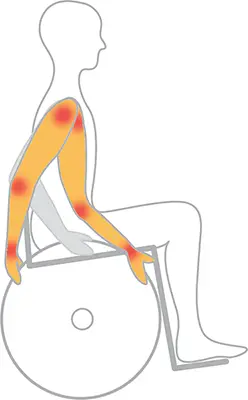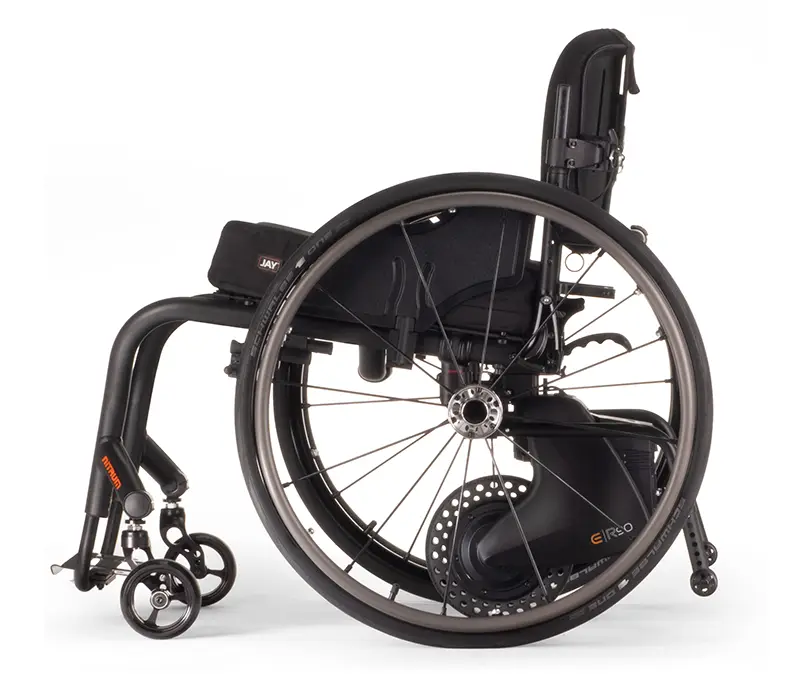Take it offline!
This Education in Motion resource is also available as a printable PDF.
Download PDF
As with all of our mobility products, Sunrise Medical recommends that a full client assessment be completed by a therapist experienced in seating and mobility, as every client's situation and presentation is unique. This information should be used as guidance during the assessment and trial process.
Repetitive Strain Injuries
There is strong evidence of increased incidence of upper limb (UL) repetitive strain injuries (RSI) among manual wheelchair users. These injuries occur due to repetitive movements and result in muscle tears, inflammation, nerve impingement, bursitis, and pain. They primarily affect the shoulders, wrists, and elbows and can manifest as rotator cuff impairments, carpal tunnel syndromes, and "tennis elbow," among other symptoms.
What Causes RSI?
Propelling a manual wheelchair involves propelling the weight of the body plus the weight of the wheelchair using extremities that were never meant to be utilized in this manner. The UL muscles and joints are much smaller than those in the lower limb (LL) and they are designed for dexterity rather than weight-bearing or stabilizing activities. In addition, propelling the chair involves using these muscles in highly repetitive movements. They may also be used in abnormal/inefficient positions if a client has poor posture or poor wheel access/wheelchair configuration.

For many manual wheelchair users, the ULs are compromised by decreased strength due to injury or disease. Overuse may occur as they compensate for other weak/non-functioning UL muscles or as they stabilize a weak trunk. There may be strain or damage from joint instability that is caused by weakness around that joint and/or increased or decreased tone. Additional risks might be seen in older clients with decreased range of motion, bone spurs, arthritis, and joint degeneration or with pediatric clients whose muscles are weaker with joints that are not fully developed.
Clinical presentations that would warrant power add-on consideration
- The client is unable to meet goals solely with a manual wheelchair due to:
- Inability to manage functional distances/speed due to upper limb weakness, pain, or range of motion limitations
- Upper limb dyskinesia that prevents functional wheelchair propulsion
- Pain with propulsion that limits the ability to meet functional goals
- Inability to manage functional endurance demands due to co-morbidities such as cardiovascular issues, cancer, or diabetes
- Inability to manage inclines and uneven terrain in the environments where they functionally must travel
- Client has difficulties or is unable to cross a street in a safe and functional time frame
- History of Repetitive Strain Injury (RSI) such as:
- Tendonitis
- Rotator Cuff Injury
- Bursitis
- Posture that limits the ability to propel a manual wheelchair with proper ergonomics such as:
- Posterior pelvic tilt/Kyphosis
- Scoliosis
- Manual propulsion is causing damage to UL structures or has the potential to cause damage
- The client cannot meet functional goals with a manual wheelchair and a power wheelchair is not a viable option:
- Environment is not suited for a power wheelchair
- Client is unable to transport a power wheelchair due to size restrictions
- Client is unable to use a power wheelchair in the home environment due to space restrictions
- Client is unable to use a power wheelchair in environments due to product weight restrictions, such as in elevators
- Experience fatigue throughout the day
- Difficulty controlling speed on downward slopes
- Would like to maintain more active lifestyle throughout the day
- Unable to carry items during propulsion
- Manage spasticity
- Would like to stay in manual wheelchair rather than move to power
Objective Measures That Can Assist With Creating a Risk Profile for RSI
Outcome measures are used to assess whether a client's Assistive Technology Device is improving symptoms and functioning in various life domains such as work, school, relationships, and community engagement. Outcomes can be used for both making clinical decisions and engaging clients in health care planning. Several objective measures can assist with tracking functional outcomes or function/pain over time when considering power add-on devices:
- 24-Hour Pain Cycle
- Wheelchair Users Shoulder Pain Index (WUSPI)
- Functioning Every Day in a Wheelchair (FEW)
- Wheelchair Outcome Measure (WHOM)
- Power Wheelchair Indoor Driving Assessment (PIDA)
The Empulse R90 Power Add-On Device
For clients who have met the criteria for power add-on devices, the Empulse R90 can help to preserve independent function & UL health and reduce the risk for future damage while still allowing independent mobility and use of the ULs.

The Empulse R90 meets these functional requirements:
- It's lightweight and transportable: the Empulse R90 is 13.0 lbs (5.9 kg).
- Its intuitive design allows many clients to securely mount the Empulse R90 while sitting in their chair.
- Offers full-day battery power: the 2.5 Ah lithium battery goes up to 9.8 miles (15.7 km). Extend the range to 19.5 miles (31.4 km) with the 5 Ah battery.
- The Empulse R90 does not increase the overall footprint of the chair, so the wheelchair remains maneuverable even in tight environments.
- The app allows the rider to optimize the R90's performance to their user weight and chair, as well as select driving profiles to match their environment.
References
- Kentar, Y. et al. 2018. Prevalence of upper extremity pain in a population of people with paraplegia. Spinal Cord 56, 695-703.
- Choukou, Best, K. L., Potvin-Gilbert, M., Routhier, F., Lettre, J., Gamache, S., Borisoff, J. F., & Gagnon, D. (2021). Scoping review of propelling aids for manual wheelchairs. Assistive Technology, 33(2), 72–86. https://doi.org/10.1080/10400435.2019.1595789
- Didier Pradon, Elodie Garrec, Isabelle Vaugier, Thierry Weissland & Caroline Hugeron (2021) Effect of power-assistance on upper limb biomechanical and physiological variables during a 6-minute, manual wheelchair propulsion test: a randomised, cross-over study, Disability and Rehabilitation, DOI: 10.1080/09638288.2021.1973586
- Elliott W. Flockhart, William C. Miller, Jory A. Campbell, Johanne L. Mattie & Jaimie F. Borisoff (2021) Evaluation of two power assist systems for manual wheelchairs for usability, performance and mobility: a pilot study, Disability and Rehabilitation: Assistive Technology, DOI: 10.1080/17483107.2021.200106
- Khalili, Eugenio, A., Wood, A., Van der Loos, M., Mortenson, W. B., & Borisoff, J. (2021). Perceptions of power-assist devices: interviews with manual wheelchair users. Disability and Rehabilitation: Assistive Technology, ahead-of-print(ahead-of-print), 1–11. https://doi.org/10.1080/17483107.2021.1906963
- Sawatzky, Mortenson, W. B., & Wong, S. (2018). Learning to use a rear-mounted power assist for manual wheelchairs. Disability and Rehabilitation: Assistive Technology, 13(8), 772–776. https://doi.org/10.1080/17483107.2017.1375562
- Wong, Mortenson, B., & Sawatzky, B. (2019). Starting and stopping kinetics of a rear mounted power assist for manual wheelchairs. Assistive Technology, 31(2), 77–81. https://doi.org/10.1080/10400435.2017.1366373